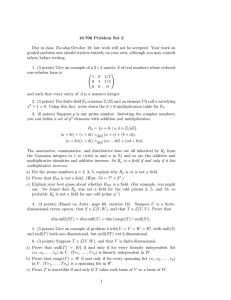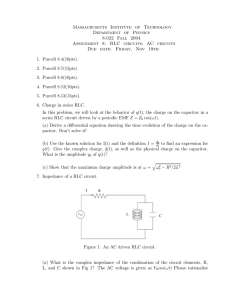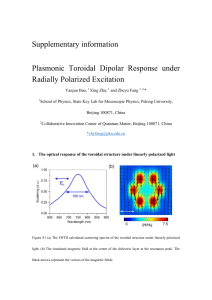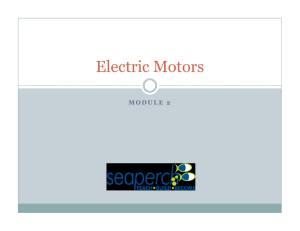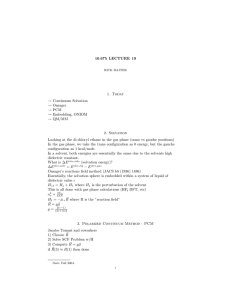MASSACHUSETTS INSTITUTE OF TECHNOLOGY Department of Electrical Engineering and Computer Science
advertisement
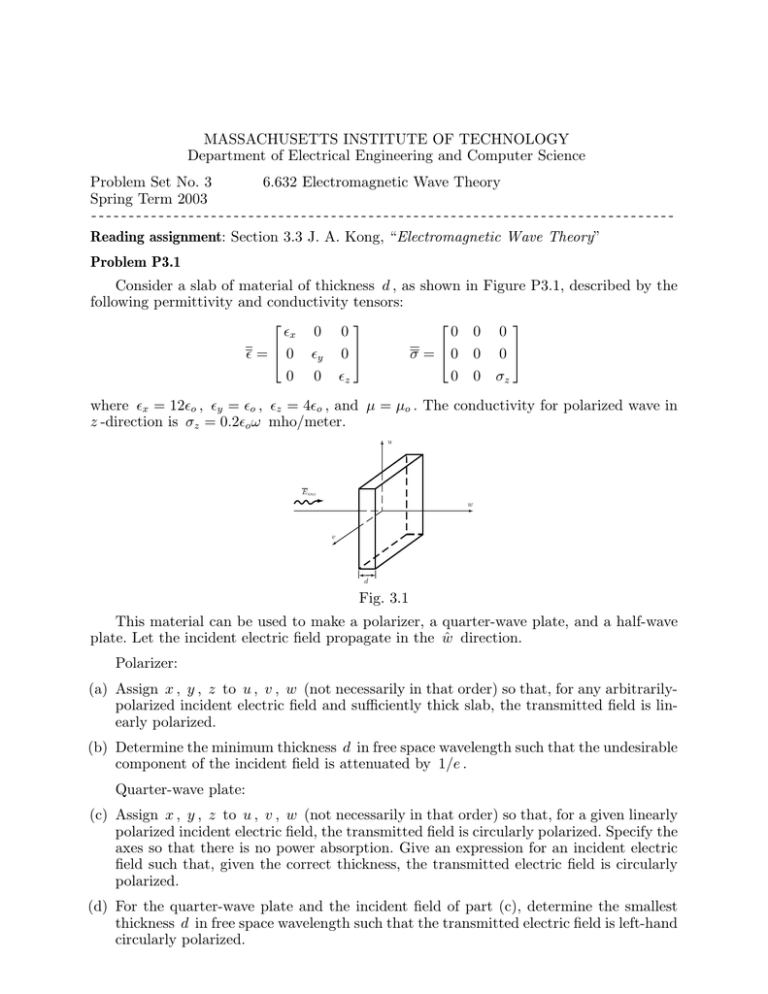
MASSACHUSETTS INSTITUTE OF TECHNOLOGY Department of Electrical Engineering and Computer Science Problem Set No. 3 6.632 Electromagnetic Wave Theory Spring Term 2003 -----------------------------------------------------------------------------Reading assignment: Section 3.3 J. A. Kong, “Electromagnetic Wave Theory” Problem P3.1 Consider a slab of material of thickness d , as shown in Figure P3.1, described by the following permittivity and conductivity tensors: x = 0 0 0 y 0 0 0 z 0 σ = 0 0 0 0 0 0 0 σz where x = 12o , y = o , z = 4o , and µ = µo . The conductivity for polarized wave in z -direction is σz = 0.2o ω mho/meter. u E inc w v d Fig. 3.1 This material can be used to make a polarizer, a quarter-wave plate, and a half-wave plate. Let the incident electric field propagate in the w ˆ direction. Polarizer: (a) Assign x , y , z to u , v , w (not necessarily in that order) so that, for any arbitrarilypolarized incident electric field and sufficiently thick slab, the transmitted field is lin­ early polarized. (b) Determine the minimum thickness d in free space wavelength such that the undesirable component of the incident field is attenuated by 1/e . Quarter-wave plate: (c) Assign x , y , z to u , v , w (not necessarily in that order) so that, for a given linearly polarized incident electric field, the transmitted field is circularly polarized. Specify the axes so that there is no power absorption. Give an expression for an incident electric field such that, given the correct thickness, the transmitted electric field is circularly polarized. (d) For the quarter-wave plate and the incident field of part (c), determine the smallest thickness d in free space wavelength such that the transmitted electric field is left-hand circularly polarized. Half-wave plate: (e) Assign x , y , z to u , v , w (not necessarily in that order) so that, for a given linearly polarized incident electric field, the transmitted field may be polarized in a direction orthogonal to the incident wave. (f) For the half-wave plate of part (e), determine the minimum thickness d in free space wavelength. Problem P3.2 The electric field energy in an anisotropic crystal with κij = κji is We = κij Di Dj /2 . Note the notation: κij Di Dj /2 = 3 3 � � κij Di Dj /2 i=1 j=1 Writing in the principal coordinate system, show that Dx2 /n2x +Dy2 /n2y +Dz2 /n2z = 2We . The above is identical to the defining equation of the index ellipsoid or the optical indicatrix. The index ellipsoid is useful in finding the two indices of refraction and the two corre­ sponding directions of the D vector associated with the two characteristic waves. Find the intersection ellipse between a plane through the origin of the index ellipsoid with the surface normal along the direction of k. Let k be in the ê3 direction, show that the two principal axes of the ellipse are in the directions of the D vectors of the two characteristic waves. Problem P3.3 In a ferrite, the magnetic moment M roughly obeys the relationship dM /dt = gµ0 M × H , where g is the gyromagnetic ratio. When a ẑ-directed dc magnetic field H 0 (zeroth ˆ 0 + H 1 , M = zM ˆ 0 + M 1 , and order) is present, the total fields take the form H = zH B = µ0 (H + M ). Find dispersion relations for the first-order fields. Show that Faraday rotation exists in the ferrite.
